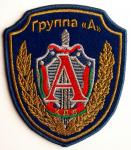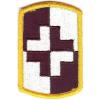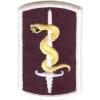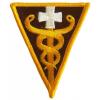Всемирная военная энциклопедия
> США
> Нашивки
> Нарукавные нашивки Сухопутных войск
> Медицинские подразделения
> US-PTMED-00028

Нарукавный знак Объединенного Медицинского командования ВС США
Случайные:

Эмблема на фуражку "petty officer" (старшина) на период Георга VI ( до 1952г.).

шеврон группы "Альфа" КГБ РБ(парадный вариант)

24th Infantry Division( obsolute) ~1950-60
Редактировать или перевести информацию
Description
On a maroon shield with a 1/8 inch (.32 cm) white border 3 inches (7.62 cm) in height and 2 1/2 inches (6.35 cm) in width overall a red cross with a small semi-circle at the end of each arm fimbriated black bearing a white five-pointed star, overall a yellow torch enflamed yellow and red below two stylized yellow wings.
Symbolism
Maroon and white are the colors associated with the U.S. Army Medical Department. The red cross, a symbol of medical assistance and aid, represents the unit’s mission. The star, a symbol of leadership, refers to the state of Texas and the first Joint Medical Command. The torch and wings refer to the assignment of the unit to Air Training Command and symbolize training and mobility.
Background
The shoulder sleeve insignia was approved on 27 April 1989. (TIOH Dwg. No. A-1-762)
On a maroon shield with a 1/8 inch (.32 cm) white border 3 inches (7.62 cm) in height and 2 1/2 inches (6.35 cm) in width overall a red cross with a small semi-circle at the end of each arm fimbriated black bearing a white five-pointed star, overall a yellow torch enflamed yellow and red below two stylized yellow wings.
Symbolism
Maroon and white are the colors associated with the U.S. Army Medical Department. The red cross, a symbol of medical assistance and aid, represents the unit’s mission. The star, a symbol of leadership, refers to the state of Texas and the first Joint Medical Command. The torch and wings refer to the assignment of the unit to Air Training Command and symbolize training and mobility.
Background
The shoulder sleeve insignia was approved on 27 April 1989. (TIOH Dwg. No. A-1-762)
Еще из категории: Медицинские подразделения
 Нарукавный знак 4 медицинской бригады СВ США
Нарукавный знак 4 медицинской бригады СВ США
 Нарукавный знак 804 медицинской бригады СВ США
Нарукавный знак 804 медицинской бригады СВ США
 Нарукавный знак 30 медицинской бригады СВ США
Нарукавный знак 30 медицинской бригады СВ США
 Нарукавный знак 3 медицинского командования СВ США
Нарукавный знак 3 медицинского командования СВ США
 Нарукавный знак 112 медицинской бригады СВ США
Нарукавный знак 112 медицинской бригады СВ США


